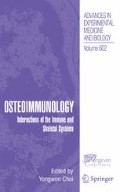Schnurri-3, a large zinc finger protein distantly related to Drosophila Shn, is a potent and essential regulator of adult bone formation. Mice lacking Shn3 display an osteosclerotic phenotype with profoundly increased bone mass due to augmented osteoblast activity. Shn3 controls protein levels of Runx2, the principal regulator of osteoblast differentiation, by promoting its degradation. In osteoblasts, Shn3 functions as a component of a trimeric complex between Runx2 and the E3 ubiquitin ligase WWP1. This complex inhibits Runx2 function and expression of genes involved in extracellular matrix mineralization due to the ability of WWP1 to promote Runx2 polyubiquitination and proteasome-dependent degradation. Our study reveals an essential role for Shn3 as a regulator of postnatal bone mass. Compounds designed to block Shn3/WWP1 function may be possible therapeutic agents for the treatment of osteoporosis.
Access this chapter
Tax calculation will be finalised at checkout
Purchases are for personal use only
Preview
Unable to display preview. Download preview PDF.
References
Affolter, M., T. Marty, M.A. Vigano, and A. Jazwinska. 2001. Nuclear interpretation of Dpp signaling in Drosophila. Embo J 20(13): 3298–3305.
Ducy, P., M. Starbuck, M. Priemel, J. Shen, G. Pinero, V. Geoffroy, M. Amling, and G. Karsenty. 1999. A Cbfa1-dependent genetic pathway controls bone formation beyond embryonic development. Genes Dev 13(8): 1025–1036.
Ingham, R.J., G. Gish, and T. Pawson. 2004. The Nedd4 family of E3 ubiquitin ligases: functional diversity within a common modular architecture. Oncogene 23(11): 1972–1984.
Jones, D.C., M.N. Wein, M. Oukka, J.G. Hofstaetter, M.J. Glimcher, and L.H. Glimcher. 2006. Regulation of adult bone mass by the zinc finger adapter protein Schnurri-3. Science 312(5777): 1223–1227.
Karsenty, G., and E.F. Wagner. 2002. Reaching a genetic and molecular understanding of skeletal development. Dev Cell 2(4): 389–406.
Komori, T., H. Yagi, S. Nomura, A. Yamaguchi, K. Sasaki, K. Deguchi, Y. Shimizu, R.T. Bronson, Y.H. Gao, M. Inada, M. Sato, R. Okamoto, Y. Kitamura, S. Yoshiki, and T. Kishimoto. 1997. Targeted disruption of Cbfa1 results in a complete lack of bone formation owing to maturational arrest of osteoblasts. Cell 89(5): 755–764.
Lee, B., K. Thirunavukkarasu, L. Zhou, L. Pastore, A. Baldini, J. Hecht, V. Geoffroy, P. Ducy, and G. Karsenty. 1997. Missense mutations abolishing DNA binding of the osteoblast-specific transcription factor OSF2/CBFA1 in cleidocranial dysplasia. Nat Genet 16(3): 307–310.
Li, J., I. Sarosi, X.Q. Yan, S. Morony, C. Capparelli, H.L. Tan, S. McCabe, R. Elliott, S. Scully, G. Van, S. Kaufman, S.C. Juan, Y. Sun, J. Tarpley, L. Martin, K. Christensen, J. McCabe, P. Kostenuik, H. Hsu, F. Fletcher, C.R. Dunstan, D.L. Lacey, and W.J. Boyle. 2000. RANK is the intrinsic hematopoietic cell surface receptor that controls osteoclastogenesis and regulation of bone mass and calcium metabolism. Proc Natl Acad Sci USA 97(4): 1566–1571.
Mundlos, S., F. Otto, C. Mundlos, J.B. Mulliken, A.S. Aylsworth, S. Albright, D. Lindhout, W.G. Cole, W. Henn, J.H. Knoll, M.J. Owen, R. Mertelsmann, B.U. Zabel, and B.R. Olsen. 1997. Mutations involving the transcription factor CBFA1 cause cleidocranial dysplasia. Cell 89(5): 773–779.
Nakashima, K., X. Zhou, G. Kunkel, Z. Zhang, J.M. Deng, R.R. Behringer, and B. de Crombrugghe. 2002. The novel zinc finger-containing transcription factor osterix is required for osteoblast differentiation and bone formation. Cell 108(1): 17–29.
Otto, F., A.P. Thornell, T. Crompton, A. Denzel, K.C. Gilmour, I.R. Rosewell, G.W. Stamp, R.S. Beddington, S. Mundlos, B.R. Olsen, P.B. Selby, and M.J. Owen. 1997. Cbfa1, a candidate gene for cleidocranial dysplasia syndrome, is essential for osteoblast differentiation and bone development. Cell 89(5): 765–771.
Oukka, M., S.T. Kim, G. Lugo, J. Sun, L.C. Wu, and L.H. Glimcher. 2002. A mammalian homolog of Drosophila schnurri, KRC, regulates TNF receptor-driven responses and interacts with TRAF2. Mol Cell 9(1): 121–131.
Oukka, M., M.N. Wein, and L.H. Glimcher. 2004. Schnurri-3 (KRC) interacts with c-Jun to regulate the IL-2 gene in T cells. J Exp Med 199(1): 15–24.
Patterson, C. 2002. A new gun in town: the U box is a ubiquitin ligase domain. Sci STKE 2002(116): PE4.
Pickart, C.M. 2004. Back to the future with ubiquitin. Cell 116(2): 181–190.
Stein, G.S., J.B. Lian, A.J. van Wijnen, J.L. Stein, M. Montecino, A. Javed, S.K. Zaidi, D.W. Young, J.Y. Choi, and S.M. Pockwinse. 2004. Runx2 control of organization, assembly and activity of the regulatory machinery for skeletal gene expression. Oncogene 23(24): 4315–4329.
Whyte, M.P. 2003. Sclerosing Bone Disorders. Primer on the metabolic Bone Diseases and Disorders of mineral metabolism (5th ed). The American Society for Bone and Mineral Research; 449–465.
Wu, L.C., C.H. Mak, N. Dear, T. Boehm, L. Foroni, and T.H. Rabbitts. 1993. Molecular cloning of a zinc finger protein which binds to the heptamer of the signal sequence for V(D) J recombination. Nucleic Acids Res 21(22): 5067–5073.
Yamashita, M., S.X. Ying, G.M. Zhang, C. Li, S.Y. Cheng, C.X. Deng, and Y.E. Zhang. 2005. Ubiquitin ligase Smurf1 controls osteoblast activity and bone homeostasis by targeting MEKK2 for degradation. Cell 121(1): 101–113.
Yang, X., K. Matsuda, P. Bialek, S. Jacquot, H.C. Masuoka, T. Schinke, L. Li, S. Brancorsini, P. Sassone-Corsi, T.M. Townes, A. Hanauer, and G. Karsenty. 2004. ATF4 is a substrate of RSK2 and an essential regulator of osteoblast biology; implication for Coffin-Lowry Syndrome. Cell 117(3): 387–398.
Zamurovic, N., D. Cappellen, D. Rohner, and M. Susa. 2004. Coordinated activation of notch, Wnt, and transforming growth factor-beta signaling pathways in bone morphogenic protein 2-induced osteogenesis. Notch target gene Hey1 inhibits mineralization and Runx2 transcriptional activity. J Biol Chem 279(36): 37704–37715.
Author information
Authors and Affiliations
Editor information
Editors and Affiliations
Rights and permissions
Copyright information
© 2007 Springer Science+Business Media, LLC
About this paper
Cite this paper
Jones, D.C., Wein, M.N., Glimcher, L.H. (2007). Schnurri-3: A Key Regulator of Postnatal Skeletal Remodeling. In: Choi, Y. (eds) Osteoimmunology. Advances in Experimental Medicine and Biology, vol 602. Springer, Boston, MA. https://doi.org/10.1007/978-0-387-72009-8_1
Download citation
DOI: https://doi.org/10.1007/978-0-387-72009-8_1
Publisher Name: Springer, Boston, MA
Print ISBN: 978-0-387-72008-1
Online ISBN: 978-0-387-72009-8
eBook Packages: Biomedical and Life SciencesBiomedical and Life Sciences (R0)

